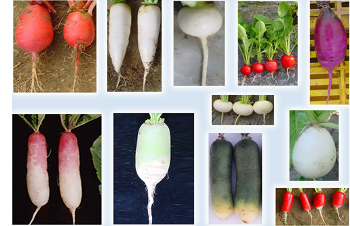|
RadishBase is a genomic and genetic database for radish. Radish (Raphanus sativus L., 2n = 2x = 18) belongs to the family Brassicaceae and is an economically important crop grown and consumed all over the world, especially in East Asia. Radish is one of the most common root vegetables, while in some cultivars it can be used as a leafy vegetable, silique vegetable, or oil crop. Various types of radish landraces and traditional varieties with different root sizes, shapes, colors, and taste have been developed through domestication, evolution and breeding.

The genus Raphanus originated from coastal regions along the Mediterranean and Black Seas (Kaneko et al, 2007). Most scholars believe that cultivated radish (R. sativus L.) was originated from wild radish (Raphanus raphanistrum L.) while others thought R. sativus was derived by the hybridization between R. maritimus and R. landra (Kaneko et al, 2007; Kitamura, 1958; Arumuganathan and Earle, 1991). During the process of spreading, different variations gradually evolved in different places all over the world, such as mostly fresh edible cherry radish (R. sativus L. var. radicola Pers), oil radish (R. sativus L. var. oleifera), feed radish (R. sativus L. var. caudatus), black radish (R. sativus L. var. niger) and large root radish (Daikon) (R. sativus L. var. longipinnatus Bailey).
Wild radish, R. raphanistrum L. ssp. Raphanistrum, has successfully colonized in a variety of locations, leading to its naturalization on all continents except Antarctica (Holm et al. 1997). It has also become a major agricultural weed, causing yield losses in a number of crops in North America (Webster and MacDonald 2001; Warwick and Francis 2005), Europe (Bostrom et al. 2003), and Australia (Streibig et al. 1989; Cousens et al. 2001).
References
- Arumuganathan K, Earle ED (1991) Nuclear DNA content of some important plant. Plant Mol Biol Rep 9:208-218
- Bostrom U, Milberg P, Fogelfors H (2003) Yield loss in spring-sown cereals related to the weed flora in the spring. Weed Sci 51:418-424.
- Cousens RD, Warringa JW, Cameron JE, Hoy V (2001) Early growth and development of wild radish (Raphanus raphanistrum L.) in relation to wheat. Aust J Agric Res 52 755-769
- Holm L, Doll J, Holm E, Pancho J, Herberger J (1997) World Weeds. Natural Histories and Distribution. Wiley, New York
- Kaneko Y, Kimizuka-Takagi C, Bang SW, Matsuzawa Y (2007) Radish. In: Kole C., editor. Genome Mapping and Molecular Breeding in Plants. vol. 5. New York: Springer: pp. 141-160
- Kitamura S (1958) Cultivars of radish and their change. In: Nishiyama I, eds. Japanese Radish. Tokyo: Japan Society for the Promotion of Science; pp. 1-19. (in Japanese)
- Streibig JC, Combellack JH, Pritchard GH, Richardson RG (1989) Estimation of thresholds for weed control in Australian cereals. Weed Res 29:117-126
- Webster TM, MacDonald GE (2001) A survey of weeds in various crops in Georgia. Weed Technol 15:771-790
- Warwick SI, Francis A (2005) The biology of Canadian weeds. 132. Raphanus raphanistrum L. Can J Plant Sci 85:709-733
|







